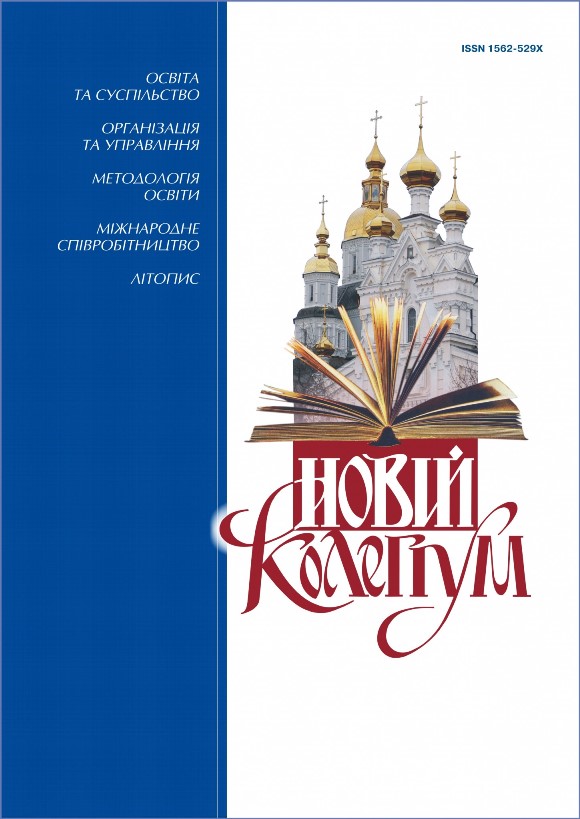Social partnership in education: implementation practice at the local level (the results of a new experiment of the People's Ukrainian Academy)
DOI:
https://doi.org/10.30837/nc.2021.2.44Keywords:
social partnership, education, educational and scientific complex of lifelong education, social experiment, stakeholders, organizational forms of social partnershipAbstract
This article attempts to analyze the problem of social partnership in educational sphere, based on the results of the experiment of the People's Ukrainian Academy on the formation and development of social partnership as an effective factor in ensuring the stability and prospects of education. The demand for the idea of social partnership in educational sphere as an effective factor in ensuring stability and further development of educational systems has been substantiated. The potential of classical sociological theories in the study of social partnership is revealed, the main theoretical aspects of the implementation of social partnership in educational sphere are determined. The directions of the research developments of domestic scientists on the state and trends in the development of social partnership, reforming higher education based on the consolidation of efforts of stakeholders, technologies of social partnership, stakeholder relations, problems of trust in educational sphere are presented.
The analysis of theoretical developments and practical implementation of intermediate results of research and experimental work within the framework of the experiment is presented. Attention is drawn to such types of social partnership in education, which define partnership as a system of relationships between the subjects of the educational process and the educational institution; partnership as a level of the organization of relations between an educational institution and external social structures.
The effective principles of joint activities are highlighted such as: consistency; voluntariness; trust; interrelation and interdependence of actions of stakeholders; flexibility and mobility; continuity, common values. Organizational and coordinating forms of social partnership have been determined, which have already proven their effectiveness. Among them, the following can be found: a board of trustees, an advisory board on financial and investment issues, a resource center for social partnership at the regional level; resource center for social partnership on the basis of an educational institution; a council of partners of the educational institution. Priority directions for further implementation of the experiment have been determined.
References
Дюркгейм Э. О разделении общественного труда ; пер. с фр. А. Б. Гофмана. Москва : Канон, 1996. С. 432.
Вебер М. Избранные произведения. Москва : Прогресс, 1990. С. 628.
Парсонс Т. Понятие общества: компоненты и их взаимоотношения // Современная западная теоретическая социология. Москва : ИНИОН РАН, 1994. [Электронный ресурс]. URL: http://socioworld.narod.ru/text/history/par_strf.html (дата обращения: 19.11. 2020).
Немецкая социология ; под ред. Н. Л. Полякова, В. В. Афанасьева. Москва : «Канон+» РООИ «Реабилитация», 2010. С. 44–64.
Хабермас Ю. Философский дискурс о модерне. Москва : Весь мир, 2003. С. 326. [Электронный ресурс] URL: http://socioline.ru/ pages/yu-habermas-filosofskij-diskurs-o-moderne (дата обращения: 10.12.2020).
Billett S., Seddon T. Building community through social partnerships around vocational education and training // Journal of Vocational Education and Training. 2004. Vol.56, No.1. Pp.51–67.
Социальное партнерство в образовании: ключевые маркеры анализа / Е. В. Астахова, Е. В. Батаева, Е. Г. Михайлева, И. С. Нечитайло ; Нар. укр. акад. Харьков : Изд-во НУА, 2019. 84 с.
Взаимодействие образовательных учреждений со стейкхолдерами: веление времени : материалы XV междунар. науч.-практ. конф., Харьков, 16 февр. 2017 г. / М-во образования и науки Украины, Ин-т высшего образования НАПН Украины, Харьк. гуманитар. ун-т «Нар. укр. акад.» [и др. ; редкол.: Е. В. Астахова (гл. ред.) и др.]. Харьков : Изд-во НУА, 2017. 308 с.

